Is the Shutdown of Nuclear Reactors Really Costing 3.6 Trillion Yen? A Comparative Analysis of the Government’s Fuel Cost Estimate (2015)
The Government’s Estimate Ignores Effects of Energy Savings and Renewable Energy on Reducing Fuel Cost.
in Japanese
Japan Renewable Energy Foundation (JREF)
The government’s estimation of “additional fuel cost attributable to the shutdown of nuclear reactors,” a figure used by the Ministry of Economy, Trade and Industry (METI) for its various committees, shows a growing gap with the reality.
In April this year, METI’s Electricity Supply-Demand Verification Subcommittee estimated the additional fuel cost attributable to the shutdown of nuclear reactors in FY2014 at “3.4 trillion yen.” ⅰ This figure is often referred to by committees under METI’s Advisory Committee for Natural Resources and Energy and Japan’s Energy White Paper 2015, as well as cited by the media, as a figure to validate the necessity and urgency of restarting the nuclear reactors. Since 2012, the government has been releasing its estimates on a semi-annual basis.
In comparison, Japan Renewable Energy Foundation (JREF) has made its own estimate of the actual increase in fuel costs between FY2010 and FY2014, with an outcome of “1.8 trillion yen.” The above-mentioned figure presented by the government’s Electricity Supply-Demand Verification Subcommittee, 3.4 trillion yen, is almost double that of JREF. Why is the Subcommittee’s estimate of additional fuel cost so much larger than it really is? The answer lies in their estimation methodology. ⅱ

Figure: Estimated additional fuel cost attributable to shutdown of nuclear reactors (FY2014)
Firstly, the Subcommittee does not in fact estimate the actual increases in fossil-fuel generated power or in fuel cost between FY2010 and FY2014. Their estimate is based on the simplified assumption that if the Fukushima Daiichi Nuclear Power Plant accident had not occurred and nuclear stations had been kept in normal operation, they would have produced 274.8 TWh of electricity in FY2014 (the average annual nuclear-generated power between FY2008 and FY2010), which could have replaced some 3.4 trillion yen of fossil fuel. ⅲ
In contrast, JREF calculated the “actual” increases in fuel cost for fossil-generated power between FY2010 and FY2014. Statistics show that in FY2010 nuclear reactors produced 288.2 TWh of electricity, while the additional electricity generated by fossil fuel in FY2014 compared with FY2010 was less than 288.2TWh.
Actually, with the prevalence of energy savings and efficiency, and the broader adoption of renewable energy, general electricity utilities only had to produce an additional 163.8 TWh of power with their fossil fuel power plants in FY2014. ⅳ Using unit fuel prices adopted by the Subcommittee, this additional fossil-fuel generated electricity gives an estimated increase in fuel cost of 1.8 trillion yen. The Subcommittee’s estimate fails to take into account such factors that help reduce the additional electricity that fossil fuel power plants needed to produce, thus presenting a much larger number than the actual increase in fuel cost for additional thermal power.
The first problem with the Subcommittee’s figure is that it overestimates the increase in fuel cost for fossil fuel power plants after the shutdown of nuclear stations at 3.4 trillion yen, despite the actual addition being 1.8 trillion yen. Furthermore, their estimation methodology carries another significant problem as it conceals the significant reduction in additional fuel cost as a result of the prevalence of energy savings and efficiency, and the broader adoption of renewable energy in Japanese society. As shown by JREF’s 1.8 trillion yen cost increase estimate, efforts made by electricity utilities and consumers to promote energy savings and efficiency and renewables greatly contributed to holding down any increases in fuel cost before the nuclear reactors restart, an achievement of great significance. It is highly likely that with further expansion of energy savings and renewables, the increase in cost for additional fossil-fuel generated electricity compared with the 2010 level will be reduced even beyond 1.8 trillion yen.
The figure of 1.8 trillion yen also includes the effect of a significant increase in fuel price since FY2011 - some 0.8 trillion yen. If this effect is omitted, the impact of the shutdown of nuclear reactors is estimated to be around one trillion yen. ⅴ Given that the significant increase in estimated fuel cost since FY2011 also reflects the factor of higher fuel prices, including this effect as part of the result of the nuclear shutdown is not appropriate.
This year the crude oil price has significantly declined, to even the level of before the 2011 earthquake. While of course it will depend upon the price from now, with a greatly reduced impact of fuel prices (some 0.8 trillion yen), the additional fuel cost for FY2015 is thought likely to fall to almost one trillion yen. On top of that, with greater prevalence of energy savings and renewables, further decline in the amount of additional electricity needed to be produced by fossil fuel power plants is also expected.
Rather than the restart of nuclear stations, the prevalence of energy savings and efficiency, and a broader adoption of renewable energy will have more important roles to play as a more practical solution to reduce the additional cost of fuel compensating for the nuclear shutdown and to prevent the outflow of wealth from Japan.
ⅰ Report of the Electricity Supply-Demand Verification Subcommittee
http://www.meti.go.jp/press/2015/04/20150430003/20150430003.html
ⅱ JREF has previously pointed out problems with their estimate (See, for instance, “Is the Shutdown of Nuclear Reactors Really Costing 3.6 Trillion Yen? A Comparative Analysis of the Government’s Fuel Cost Estimate,” March 2014)
ⅲ The estimated value of fossil fuel to be replaced takes into account the latest distribution of fossil fuel power plants by fuel type.
ⅳ Some of the decrease may be attributable to the shift of electricity demand to other types of suppliers.
ⅴ An estimated increase in fuel cost needed to make up for the shutdown of nuclear reactors in 2014 based on the assumption that fuel prices stay at the 2010 level.

